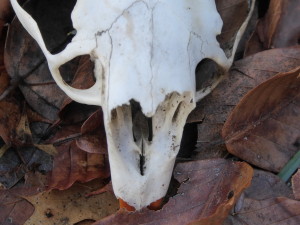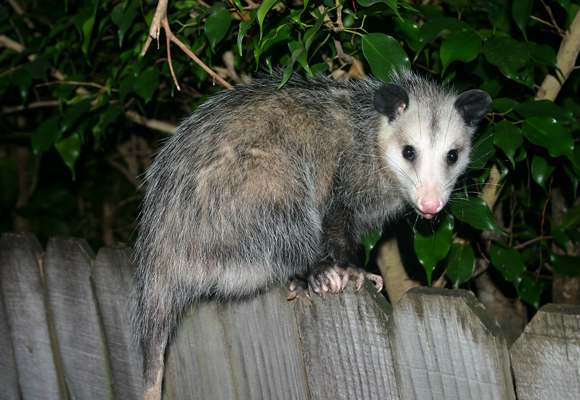Forest Forensics
 While tracking out behind my house, I settled in for a quick lunch half way up a gully overlooking a brook that was moving swiftly from the melting snow. As I stood up to seek a way through the thick laurel, I spotted clumps of hair poking through the leaf litter. Pulling back the leaves, I discovered a voluminous pile of hair and quills of a porcupine. As I probed the site, I discovered the skull a few feet away.
While tracking out behind my house, I settled in for a quick lunch half way up a gully overlooking a brook that was moving swiftly from the melting snow. As I stood up to seek a way through the thick laurel, I spotted clumps of hair poking through the leaf litter. Pulling back the leaves, I discovered a voluminous pile of hair and quills of a porcupine. As I probed the site, I discovered the skull a few feet away.
In examining it, I noticed the bones on the upper ridge of the nasal cavity had been broken. My forensic conclusion is that a fisher likely predated upon it. Fishers will attempt to corner porcupines and then lash out at their quill free faces. When the animal weakens from blood loss, they will sometimes then go for the throat. Eventually, the fisher will feed on the porcupine through the belly, which is also free of quills.

Discovered: Longest Mammal Migration in the Lower 48
“When wildlife biologist Hall Sawyer strapped radio collars to dozens of mule deer wandering southwestern Wyoming’s Red Desert in January 2011, he thought the humble animals were as rooted as the landscape’s windblown sage, low hills and staked fence posts.
Then the deer vanished out of radio range.
He chartered a plane to search all of western Wyoming. When the pilot found them, Sawyer was amazed. In just a few months, hundreds of Red Desert deer had walked more than 150 miles north into the craggy mountains south of Yellowstone National Park. Their trek, a 300-mile round trip, marks the longest known migration of any mammal in the contiguous United States.” – From Revealed: Biologists discover longest mammal migration in Lower 48 by Nate Schweber
For more information, see the article at article at Al Jazeera America and the Wyoming Migration Initiative.
What the Robin Knows
Our woods are waking up from their winter sleep, and birds are moving about in greater numbers, and even returning from warmer latitudes down south. As this happens, my ears are filled with the songs and conversations of these keenly observant creatures: what can I learn from them?
In this short video Jon Young introduces us to the concept of bird language, a form of auditory tracking and situational/landscape awareness.
A blue jay sounds an alarm several hundred yards away: the brush is thick, but now I know they’ve identified a threat.
Numerous birds are singing away: with no threats or territorial disputes to negotiate they let their guard down and chirp away. What sounds do you hear, and what are they telling you?
Have Experts Confirmed Mountain Lion in Winchester MA?
Not even 10 miles outside of Boston, Winchester, MA has become the latest town to experience the drama that often surrounds mountain lions in the Northeast.
While the last official sighting in Massachusetts of one of these big cats took place in the 19th century, New England residents have been seeing mountain lions, as well as their tracks and scat, for many years. But, the crux of many arguments doesn’t revolve around just their presence, but also whether or not there is a breeding population present in our woods. The general consensus seems to be: we are seeing mountain lions, but they have traveled here from other locations. In fact, the cat that was struck and killed on a Connecticut highway just under three years ago is supposed to have traveled from South Dakota based on genetic data.
Regardless, national mountain lion experts have weighed in on the current discovery of mountain lion sign in Winchester, analyzing the photographic evidence, and have concluded that there is a big cat in the area. However, state officials and local academics disagree with the assessment saying that the tracks found are most likely from another animal.
This recent New York Times article contains some helpful information about the current state of mountain lions, and this article tells us more about the situation in Winchester.
(Another Reason) Why You Should Brake for Possums

Unfortunately, Lyme Disease and other tick-borne illnesses have become commonplace in the Northeast. Speaking from personal experience, they’re no fun, which is why this article grabbed my attention. Aside from being another example of the connections that sometimes exist in nature without our knowing, it provides interesting information on how possums, who’s movements will increase as we say ‘Goodbye’ to winter, can lower tick population numbers.
For the full article and accompanying WAMC podcast, visit the Cary Institute of Ecosystem Studies.
And for more information on Adventure In, Adventure Out’s tracking and adventure programs, please visit our website.
Adventures in the Valley – Pudding stone caves.
Nestled amongst the craggy sandstone rock formations on the North-West side of Mt. Toby is perhaps one of the most enchanting hidden places in the Pioneer Valley…
The “Pudding Stone” cave, named for the conglomeration of small stones glued together by a sandstone mortar that make up this rock formation, is one of the few caves in the Valley that is actually large enough to walk through. If you are looking for adventure, this is the place to go.
Consisting of two main chambers connected by a twisting rocky hallway this cave is refuge to many local animals in both the summer and winter months. In the summer you’ll find (and smell) the porcupines that call this cave their home, evidenced by large piles of cashew-shaped scat and the occasional discarded quill. In the winter this cave is refuge for many hibernating insects as well as a small population of little brown bats.
Sign of porcupine living in and near this cave indicate that it has been in use by these animals for decades, at the very least. Exploring this section of Mt. Toby you will find many freshly cut hemlock and oak (depending on the time of year) twigs littering the ground. Many of the hemlocks that you find near a porcupine den with have a ‘bushy’ look to them as a result of annual trimmings from the powerful beaver-like teeth of this animal.
Small secluded caves like this are incredibly important to local bat species due to the introduction of ‘white nose fungus’, a European disease that is affecting bats all throughout the United States and Canada.
Also of note is the large and charismatic fissure that splits the ground a little further uphill from the caves themselves. The ground above the caves is covered with many smaller fissures which give this cave a very well lit, non-claustrophobic feel.
The Northernmost section of the cave opens up on a narrow, cliff-side path that leads around both sides of the rock formation. The main chamber is accessible through this entrance and is what makes this cave the hidden gem that it is. In the winter, if you are lucky, the combination of a cold Northern breeze and water dripping through the ceiling creates the most beautiful columns of ice which grow up from the floor in some of the most surreal and fantastic of ways. Reminiscent of crystal, these ice formations are sometimes over eight feet tall and shaped like something from a Dr. Seuss storybook. Glow sticks or colored flashlights make this place absolutely magical.
Happy exploring!
 Adventure In Adventure Out
Adventure In Adventure Out